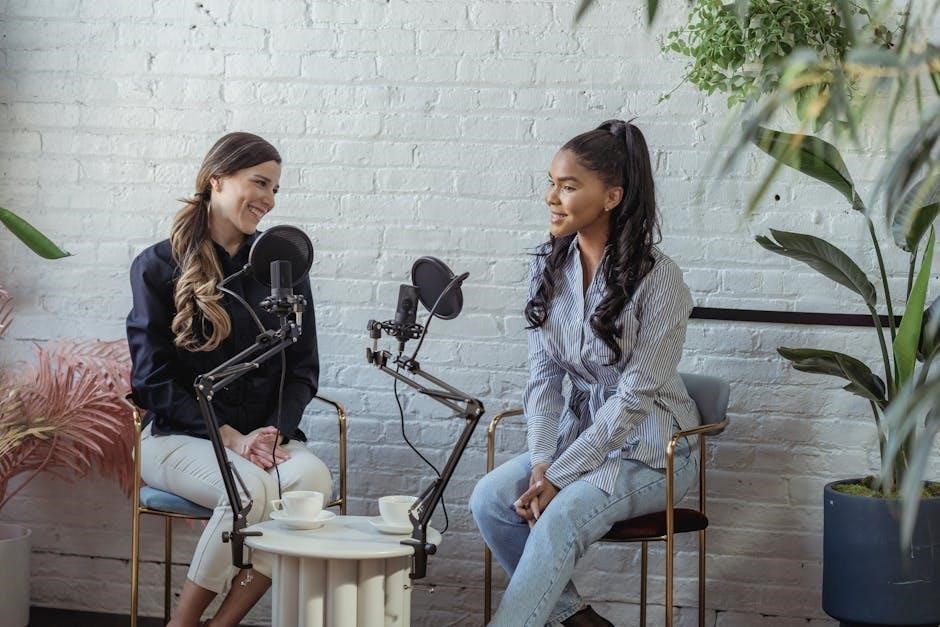“How to Talk to Anyone” by Leil Lowndes is a top-rated guide offering 92 practical techniques to enhance communication skills and build stronger relationships․ Perfect for personal and professional interactions, this book provides actionable tips to master conversations, overcome social barriers, and create lasting impressions․
Overview of the Book “How to Talk to Anyone”
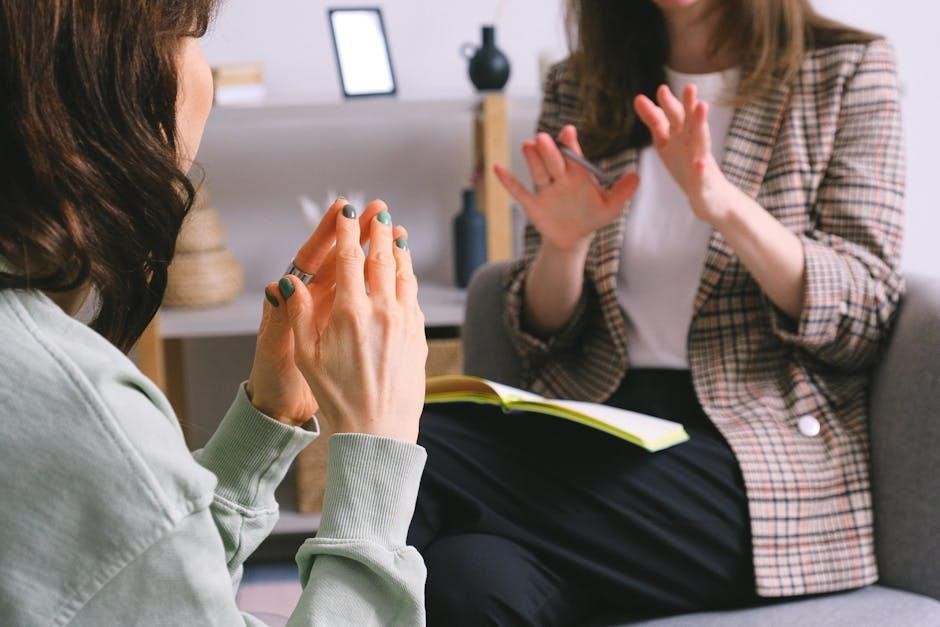
“How to Talk to Anyone” by Leil Lowndes is a comprehensive guide to improving communication and relationship-building skills․ The book offers 92 practical techniques to help readers master conversations and social interactions․ It focuses on strategies like the “Flooding Smile” and the “Hello Old Friend” technique to create instant rapport․ With tips on body language, eye contact, and active listening, this book empowers readers to navigate any social situation confidently․ Its actionable advice makes it a valuable resource for personal and professional relationships, ensuring lasting impressions and meaningful connections․
Importance of Effective Communication in Relationships
Effective communication is the cornerstone of successful relationships, both personal and professional․ It fosters trust, understanding, and emotional connection, allowing individuals to express their needs and desires clearly․ Poor communication often leads to misunderstandings and conflict, while strong communication skills can resolve disputes and strengthen bonds․ By mastering the art of conversation, individuals can navigate social dynamics seamlessly, build rapport, and create lasting impressions․ This skill is essential for personal growth, professional success, and fostering meaningful connections in all areas of life․
Structure and Key Concepts of the Book
“How to Talk to Anyone” is structured into clear sections, each focusing on specific communication techniques․ The book introduces 92 practical tricks to improve conversations, including the “Flooding Smile” and the “Hello Old Friend” methods․ It emphasizes the importance of body language, eye contact, and active listening․ The author, Leil Lowndes, breaks down complex social interactions into manageable strategies, making it easy for readers to apply these skills in real-life situations․ The book’s accessible format ensures that both novice and experienced individuals can benefit from its expert advice․
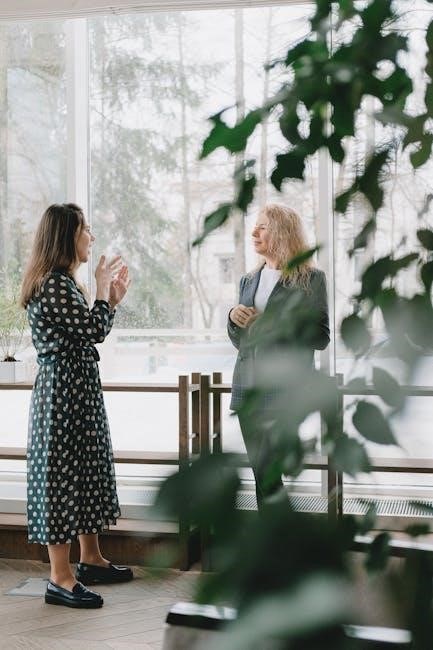
Understanding the Basics of Communication
Mastering non-verbal cues like body language, eye contact, and smiling is essential․ These elements help build connections and facilitate meaningful interactions in personal and professional settings․
The Power of Body Language
Body language is a powerful tool in communication, conveying confidence and friendliness․ Techniques like the “Flooding Smile” and maintaining focused attention on others create instant rapport․ Open postures, such as uncrossed arms, signal receptiveness, while deliberate eye contact shows genuine interest․ These non-verbal cues help establish trust and make conversations more engaging․ By mastering body language, you can subtly influence perceptions and foster meaningful connections in both personal and professional interactions․
The Role of Eye Contact in Conversations
Eye contact is a vital aspect of communication, conveying confidence and sincerity․ It helps establish trust and keeps the conversation engaging․ By maintaining focused eye contact, you show genuine interest in the other person, making them feel valued․ This technique is emphasized in “How to Talk to Anyone” as a way to build rapport and ensure active listening․ Effective eye contact can make others feel important and foster deeper connections in both personal and professional settings․
Smiling and Its Impact on First Impressions
A genuine smile is a powerful tool for creating a positive first impression․ It conveys warmth, friendliness, and confidence, making others feel at ease․ In “How to Talk to Anyone,” the “Flooding Smile” technique is highlighted as a way to instantly connect with people․ By smiling naturally and intentionally, you can build rapport and establish trust․ A well-timed smile not only enhances your approachability but also sets the tone for meaningful and engaging conversations․ It’s a simple yet effective way to make a lasting impact from the start․

Mastering the Art of First Impressions
Creating a strong first impression is crucial for effective communication․ Techniques like the “Flooding Smile” and confident body language help make a lasting impact, ensuring others perceive you positively and engage with ease․
The Flooding Smile Technique
The Flooding Smile Technique is a powerful method to create instant rapport․ Instead of immediately smiling, pause, gaze at the person, and then radiate a warm, genuine smile․ This technique conveys sincerity and makes others feel valued, fostering deeper connections․ It’s about timing and authenticity, ensuring your smile feels natural and heartfelt, which can significantly enhance first impressions and build trust in social interactions․ This approach is simple yet effective for making a lasting impact․
How to Use Positive Body Language
Positive body language is crucial for effective communication․ Uncross your arms, stand tall, and avoid fidgeting to appear open and confident․ Maintain eye contact to show focus and sincerity․ Smile naturally and use gestures to emphasize points, making conversations more engaging․ Lean forward slightly to show interest and mirror the other person’s posture to build rapport․ These non-verbal cues create a welcoming atmosphere, encouraging meaningful interactions and helping you connect more deeply with others․ Mastering these techniques enhances your ability to communicate confidently and effectively in any situation․
Creating an Aura of Confidence
Confidence is key to making a lasting impression․ Stand tall, maintain good posture, and avoid slouching․ Make steady eye contact to show self-assurance․ Smile warmly but naturally, using the “Flooding Smile” technique to create an instant connection․ Speak clearly and at a moderate pace, avoiding filler words․ Show genuine interest in others while exuding calm self-control․ Confidence isn’t arrogance; it’s about being comfortable in your own skin․ By projecting positivity and assurance, you draw people to you and build strong, meaningful connections in both personal and professional settings․ Mastery of this skill transforms everyday interactions into opportunities for success․
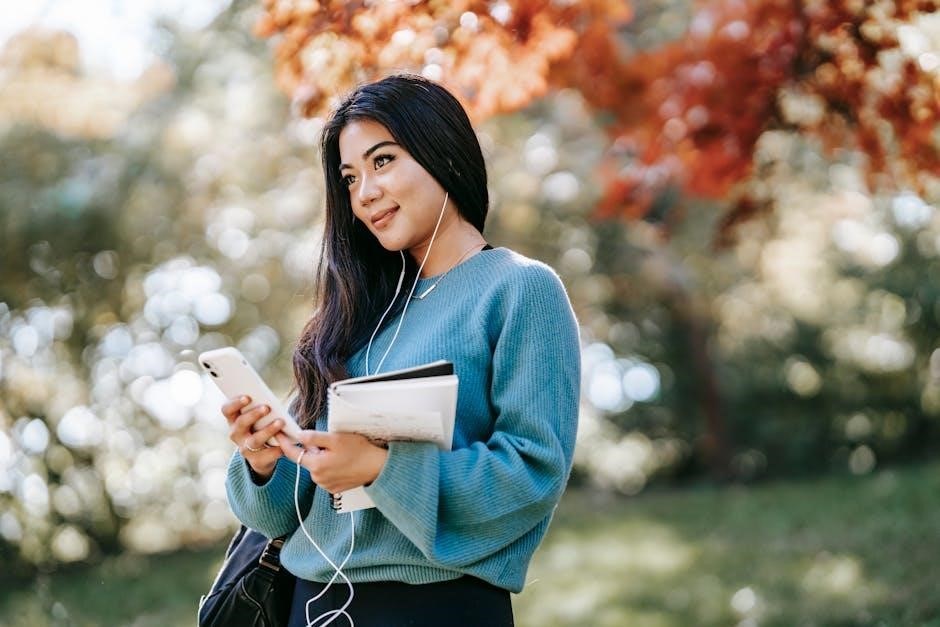
Effective Listening Skills
Mastering the balance between talking and listening is crucial․ Show genuine interest, ask open-ended questions, and avoid closed ones․ This fosters deeper connections and understanding․
Balance Between Talking and Listening
Balancing Talking and Listening
Achieving the right balance between speaking and listening is essential for effective conversations․ Leil Lowndes suggests maintaining a 2:3 ratio, where listening takes precedence․ This approach ensures that both parties feel heard and valued, fostering deeper connections․ By allowing others to share their thoughts, you demonstrate genuine interest and build rapport․ Balancing communication in this way not only enhances understanding but also makes interactions more engaging and meaningful․ This technique is a cornerstone of her 92 little tricks for relationship success․
Showing Genuine Interest in Others
Showing genuine interest in others is a powerful way to build connections․ Leil Lowndes emphasizes the importance of giving people your undivided attention and asking open-ended questions to encourage deeper conversations; Techniques like “The Hello Old Friend” approach and active listening help create a sense of warmth and engagement․ By showing curiosity and empathy, you make others feel valued, fostering trust and rapport; This approach is central to her 92 tricks for effective communication, making interactions more meaningful and relationships stronger․
Avoiding Closed Questions
Avoiding closed questions is crucial for fostering engaging conversations․ Closed questions, which often require only a “yes” or “no” answer, can limit dialogue and hinder deeper connections․ Instead, asking open-ended questions encourages the other person to share more, creating a more dynamic and meaningful exchange․ This approach, highlighted in Leil Lowndes’ techniques, helps to build rapport and keeps conversations flowing naturally, allowing for richer interactions and stronger relationships․ By focusing on open-ended inquiries, you invite others to express themselves fully, enhancing communication and connection․

Conversation Starters and Icebreakers
Mastering conversation starters is essential for engaging others effortlessly․ Techniques like the “Hello Old Friend” approach and asking open-ended questions help break the ice and foster meaningful connections․
How to Initiate a Conversation
Initiating a conversation can be effortless with the right approach․ Start with a warm smile and direct eye contact to show genuine interest․ Use open-ended questions to encourage meaningful dialogue, avoiding closed questions that lead to short answers․ Techniques like the “Hello Old Friend” method help create an instant connection, making the other person feel comfortable․ Balance talking and listening, ensuring the conversation flows naturally․ This approach fosters engagement and sets the foundation for deeper communication․ Remember, the goal is to show interest and build rapport from the very first interaction․
Using the “Hello Old Friend” Technique
The “Hello Old Friend” technique is a powerful way to create instant rapport․ By greeting someone with the warmth and familiarity of an old friend, you make them feel comfortable and valued․ This approach involves using a genuine smile, relaxed body language, and a friendly tone․ It works especially well in unfamiliar settings, helping to break the ice and establish a connection quickly․ The key is to make the interaction feel natural and sincere, ensuring the other person feels at ease from the start․ This technique fosters trust and openness in any conversation․
Asking Open-Ended Questions
Asking open-ended questions is a highly effective way to deepen conversations and encourage meaningful dialogue․ Unlike closed questions, which often result in short “yes” or “no” answers, open-ended questions prompt the other person to share more detailed thoughts and feelings․ This technique not only shows genuine interest but also helps build rapport and keeps the conversation flowing smoothly․ By asking questions that begin with “what,” “how,” or “why,” you invite the other person to open up, fostering a more engaging and connected interaction․ This approach is essential for forming lasting connections․
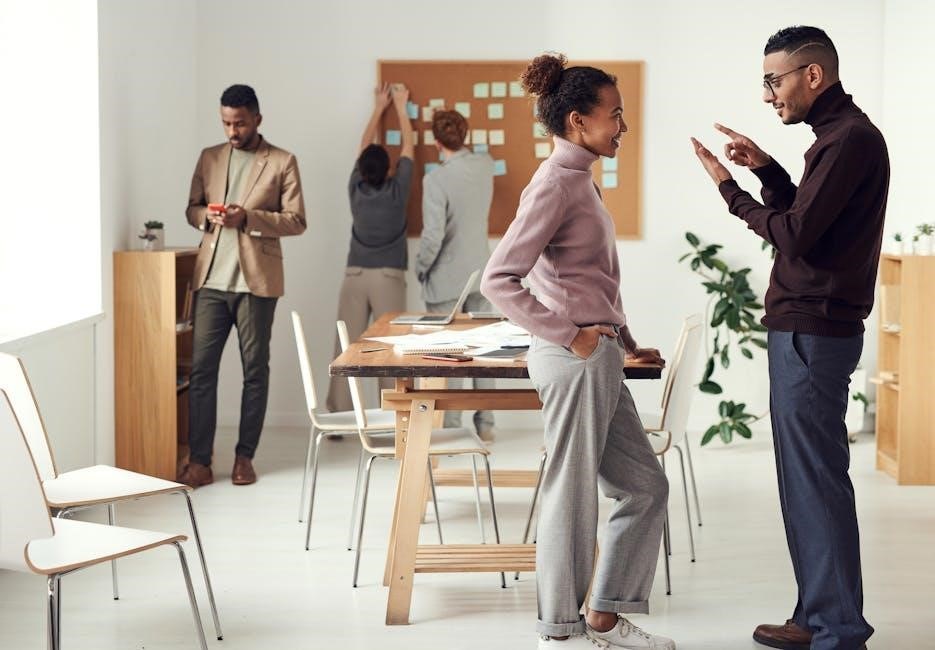
Advanced Conversation Techniques
Mastering advanced techniques like active listening, humor, and seamless topic transitions can elevate conversations to new heights, creating deeper connections and memorable interactions with ease․
How to Keep the Conversation Flowing
To keep conversations flowing smoothly, balance talking and listening, maintaining a 2:3 ratio․ Show genuine interest by asking open-ended questions and avoiding closed ones․ Use techniques like the “Hello Old Friend” approach to create comfort․ Active listening and positive body language, such as nodding and maintaining eye contact, signal engagement․ Transition topics naturally by linking them to the discussion․ Humor can lighten the mood, while pauses allow others to reflect․ These strategies ensure conversations remain dynamic, meaningful, and enjoyable for all parties involved, fostering deeper connections effortlessly․
Using Humor to Connect with Others
Humor is a powerful tool for connecting with others, as it lightens the mood and creates rapport․ In “How to Talk to Anyone,” Leil Lowndes emphasizes using wit and playful teasing to make conversations more enjoyable․ Finding common ground through shared experiences or lighthearted anecdotes can instantly build a connection․ However, humor should be used naturally and respectfully, avoiding sarcasm or jokes that might offend․ When timed appropriately, humor can turn awkward moments into opportunities for deeper engagement, making interactions more memorable and pleasant for everyone involved․
Active Listening and Engagement
Active listening is crucial for meaningful connections․ Leil Lowndes highlights the importance of being fully present and engaged during conversations․ This involves maintaining eye contact, nodding, and using verbal cues like “uh-huh” to show interest․ By focusing entirely on the speaker, you build trust and encourage them to open up․ Avoid planning your next response while they speak, as this distracts from genuine engagement․
Engagement also means asking follow-up questions and reflecting on what’s been said․ This not only deepens the conversation but also makes the other person feel valued․ Active listening and engagement are key to forming lasting connections and fostering rapport in any interaction․

Overcoming Common Challenges
Mastering conversation requires addressing common hurdles like shyness, social anxiety, and handling difficult discussions․ Leil Lowndes provides practical advice and techniques to navigate these challenges effectively․
Dealing with Shyness or Social Anxiety
Shyness and social anxiety can hinder effective communication, but Leil Lowndes offers practical strategies to overcome these challenges․ Techniques like gradual exposure to social situations, preparation, and focusing on others’ interests can help build confidence․ The book emphasizes the importance of shifting attention from self-consciousness to genuine curiosity about others․ By practicing active listening and using open-ended questions, individuals can reduce anxiety and foster meaningful connections․ These methods empower individuals to navigate social interactions with greater ease and assurance, transforming shyness into confidence over time․
Handling Difficult Conversations
Difficult conversations can be challenging, but Leil Lowndes provides strategies to navigate them effectively․ Techniques like active listening, remaining calm, and using open-ended questions help maintain control․ The book suggests focusing on understanding the other person’s perspective while expressing your own feelings clearly․ By avoiding confrontation and fostering mutual respect, you can transform tense interactions into opportunities for resolution․ These practical tips enable you to approach tough talks with confidence, ensuring constructive outcomes and strengthened relationships․ Mastering these skills helps you handle disagreements with grace and poise․
Recovering from Conversational Mistakes
Conversational mistakes are inevitable, but Leil Lowndes offers practical advice on how to recover gracefully․ Techniques like the “Hello Old Friend” method and humor can diffuse tension․ If you’ve misspoken, acknowledging the error with a light-hearted comment shows maturity․ The book emphasizes turning mistakes into opportunities to connect by staying calm and shifting focus to the other person․ These strategies help you regain composure and maintain rapport, ensuring conversations remain positive and engaging even after slip-ups․ Mastering these recovery tactics fosters resilience and strengthens relationships․

Building and Maintaining Relationships
Leil Lowndes’ techniques emphasize creating genuine connections through active listening and showing interest․ Building rapport involves balancing talk and listen ratios, using positive body language, and avoiding closed questions․ These strategies foster trust and deepen personal and professional bonds, ensuring relationships thrive over time․
How to Build Rapport with Others
Building rapport involves creating genuine connections through active listening and showing interest․ Techniques like the “flooding smile” and maintaining eye contact help establish trust․ Positive body language, such as open gestures, signals approachability․ Balancing talking and listening, with a 2:3 ratio, ensures others feel valued․ Asking open-ended questions encourages deeper conversations, fostering mutual understanding․ These strategies help build strong emotional bonds, making interactions more meaningful and relationships more enduring․ Mastery of these methods ensures lasting connections in both personal and professional settings․
Nurturing Professional Relationships
Nurturing professional relationships requires intentional communication and genuine engagement․ Active listening and showing interest in colleagues’ perspectives foster trust and collaboration․ Using techniques like the “Hello Old Friend” approach can create instant rapport, making interactions feel more natural․ Asking open-ended questions encourages deeper conversations, while positive body language conveys confidence and approachability․ Consistently demonstrating respect and empathy strengthens professional bonds, leading to stronger teamwork and mutual success․ These practices ensure long-term, productive relationships in the workplace․
Maintaining Personal Connections
Maintaining personal connections requires consistent effort and genuine engagement․ Balancing talking and listening ensures meaningful interactions, while showing genuine interest in others’ lives fosters deeper bonds․ Avoiding closed questions encourages openness, allowing relationships to grow․ Positive body language and heartfelt smiles reinforce trust and warmth․ Regular communication, even in small ways, keeps connections strong․ By prioritizing quality time and emotional support, personal relationships flourish, creating a foundation of trust and understanding that endures through life’s challenges․
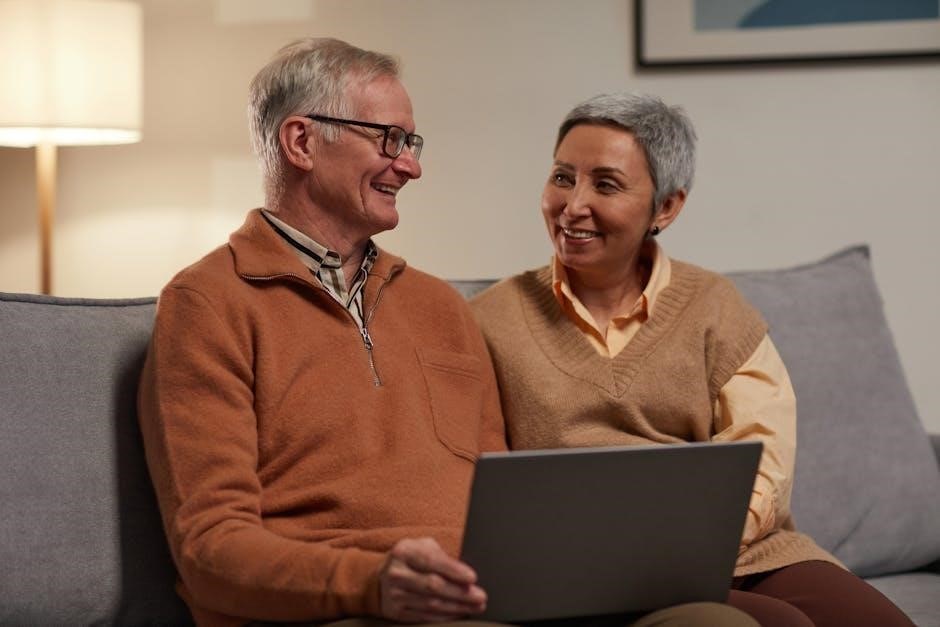
Mastering communication transforms lives, fostering deeper connections and success․ By applying Leil Lowndes’ 92 techniques, anyone can become a skilled communicator, navigating relationships with confidence and grace․
Reinforcing Key Takeaways
The book emphasizes the importance of balancing talking and listening, using positive body language, and asking open-ended questions to engage others․ Techniques like the “Flooding Smile” and “Hello Old Friend” approach help create lasting impressions․ By mastering these strategies, readers can build rapport, handle difficult conversations, and foster meaningful relationships․ Effective communication is not just about speaking but also about active listening and showing genuine interest in others․
Practical Steps to Improve Communication Skills
Implementing the “Flooding Smile” technique and maintaining eye contact can instantly enhance first impressions․ Practice active listening by balancing talking and listening in a 2:3 ratio․ Ask open-ended questions to encourage deeper conversations and avoid closed questions․ Use positive body language, such as uncrossing arms, to show approachability․ Regularly apply these strategies in daily interactions to build confidence and improve relationships․ Consistency is key to mastering the art of effective communication․
Final Thoughts on Mastering the Art of Conversation
Mastering the art of conversation requires practice, empathy, and genuine interest in others․ By applying techniques like the “Hello Old Friend” approach and balancing talk with attentive listening, anyone can become a skilled communicator․ Remember, effective conversations are about connection, not perfection․ Embrace these strategies to foster meaningful relationships and unlock personal and professional success․ Consistent effort will transform even the most challenging interactions into opportunities for growth and understanding․
